Beech
| Beech | |
|---|---|
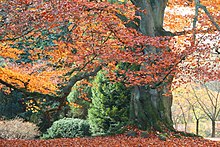
| |
| European beech (Fagus sylvatica) | |
| Scientific classification | |
| Kingdom: | Plantae |
| Clade: | Tracheophytes |
| Clade: | Angiosperms |
| Clade: | Eudicots |
| Clade: | Rosids |
| Order: | Fagales |
| Family: | Fagaceae |
| Subfamily: | Fagoideae K.Koch |
| Genus: | Fagus L. |
| Type species | |
| Fagus sylvatica | |
| Species | |
|
See text | |
Beech (Fagus) is a genus of deciduous trees in the family Fagaceae, native to subtropical (accessory forest element) and temperate (as dominant element of mesophytic forests) Eurasia and North America. There are 14 accepted species in two distinct subgenera, Englerianae Denk & G.W.Grimm and Fagus.[1] The subgenus Englerianae is found only in East Asia, distinctive for its low branches, often made up of several major trunks with yellowish bark. The better known species of subgenus Fagus are native to Europe, western and eastern Asia and eastern North America. They are high-branching trees with tall, stout trunks and smooth silver-grey bark.
The European beech Fagus sylvatica is the most commonly cultivated species, yielding a utility timber used for furniture construction, flooring and engineering purposes, in plywood, and household items. The timber can be used to build homes. Beechwood makes excellent firewood. Slats of washed beech wood are spread around the bottom of fermentation tanks for Budweiser beer. Beech logs are burned to dry the malt used in some German smoked beers. Beech is also used to smoke Westphalian ham, andouille sausage, and some cheeses.
Description
[edit]

Beeches are monoecious, bearing both male and female flowers on the same plant. The small flowers are unisexual, the female flowers borne in pairs, the male flowers wind-pollinating catkins. They are produced in spring shortly after the new leaves appear. The fruit of the beech tree, known as beechnuts or mast, is found in small burrs that drop from the tree in autumn. They are small, roughly triangular, and edible, with a bitter, astringent, or mild and nut-like taste.
The European beech (Fagus sylvatica) is the most commonly cultivated, although few important differences are seen between species aside from detail elements such as leaf shape. The leaves of beech trees are entire or sparsely toothed, from 5–15 centimetres (2–6 inches) long and 4–10 cm (2–4 in) broad.
The bark is smooth and light gray. The fruit is a small, sharply three-angled nut 10–15 mm (3⁄8–5⁄8 in) long, borne singly or in pairs in soft-spined husks 1.5–2.5 cm (5⁄8–1 in) long, known as cupules. The husk can have a variety of spine- to scale-like appendages, the character of which is, in addition to leaf shape, one of the primary ways beeches are differentiated.[2] The nuts are called beechnuts[3] or beech mast and have a bitter taste (though not nearly as bitter as acorns) and a high tannin content.
Taxonomy and systematics
[edit]The most recent classification system of the genus recognizes 14 species in two distinct subgenera, subgenus Englerianae and Fagus.[1] Beech species can be diagnosed by phenotypical and/or genotypical traits. Species of subgenus Engleriana are found only in East Asia, and are notably distinct from species of subgenus Fagus in that these beeches are low-branching trees, often made up of several major trunks with yellowish bark and a substantially different nucleome (nuclear DNA), especially in noncoding, highly variable gene regions such as the spacers of the nuclear-encoded ribosomal RNA genes (ribosomal DNA).[4][5] Further differentiating characteristics include the whitish bloom on the underside of the leaves, the visible tertiary leaf veins, and a long, smooth cupule-peduncle. Originally proposed but not formalized by botanist Chung-Fu Shen in 1992, this group comprised two Japanese species, F. japonica and F. okamotoi, and one Chinese species, F. engleriana.[2] While the status of F. okamotoi remains uncertain, the most recent systematic treatment based on morphological and genetic data confirmed a third species, F. multinervis, endemic to Ulleungdo, a South Korean island in the Sea of Japan.[1] The beeches of Ulleungdo have been traditionally treated as a subspecies of F. engleriana, to which they are phenotypically identical,[2][6] or as a variety of F. japonica.[7] The differ from their siblings by their unique nuclear and plastid genotypes.[1][8][4]
The better known subgenus Fagus beeches are high-branching with tall, stout trunks and smooth silver-gray bark. This group includes five extant species in continental and insular East Asia (F. crenata, F. longipetiolata, F. lucida, and the cryptic sister species F. hayatae and F. pashanica), two pseudo-cryptic species in eastern North America (F. grandifolia, F. mexicana), and a species complex of at least four species (F. caspica, F. hohenackeriana, F. orientalis, F. sylvatica) in Western Eurasia. Their genetics are highly complex and include both species-unique alleles as well as alleles and ribosomal DNA spacers that are shared between two or more species.[1] The western Eurasian species are characterized by morphological and genetical gradients.
Research suggests that the first representatives of the modern-day genus were already present in the Paleocene of Arctic North America (western Greenland[9]) and quickly radiated across the high latitudes of the Northern Hemisphere, with a first diversity peak in the Miocene of northeastern Asia.[10][11] The contemporary species are the product of past, repeated reticulate evolutionary processes (outbreeding, introgression, hybridization).[4] As far as studied, heterozygosity and intragenomic variation are common in beech species,[4][5][8] and their chloroplast genomes are nonspecific with the exception of the Western Eurasian and North American species.[1]
Fagus is the first diverging lineage in the evolution of the Fagaceae family,[9][12] which also includes oaks and chestnuts.[13] The oldest fossils that can be assigned to the beech lineage are 81–82 million years old pollen from the Late Cretaceous of Wyoming, United States.[9] The southern beeches (genus Nothofagus) historically thought closely related to beeches, are treated as members of a separate family, the Nothofagaceae (which remains a member of the order Fagales). They are found throughout the Southern Hemisphere in Australia, New Zealand, New Guinea, New Caledonia, as well as Argentina and Chile (principally Patagonia and Tierra del Fuego).
Species
[edit]Species treated in Denk et al. (2024) and listed in Plants of the World Online (POWO)[1]:
| Image | Name | Subgenus | Status, systematic affinity | Distribution | Accepted as species in POWO as of April 2023[14] |
|---|---|---|---|---|---|
| Fagus caspica Denk & G.W.Grimm – Caspian beech | Fagus | New species described in 2024[1]; first-diverging lineage within the Western Eurasian group | Talysch and Elburz Mountains, southeastern Azerbaijan and northern Iran | Populations included in F. sylvatica subsp. orientalis | |
| Fagus chienii W.C.Cheng | Fagus | Possibly conspecific with F. lucida[6] | Probably extinct, described from a single location in China (Sichuan). Individuals recently collected at the type locality were morphologically and genetically indistinguishable from F. pashanica.[15] | Yes | |
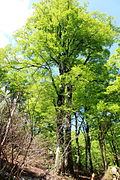 |
Fagus crenata Blume – Siebold's beech or Japanese beech | Fagus | Widespread species; complex history connecting it to both the Western Eurasian group and the other East Asian species of subgenus Fagus[4] | Japan; in the mountains of Kyushu, Shikoku and Honshu, down to sea-level in southern Hokkaido. | Yes |
 |
Fagus engleriana Seemen ex Diels – Chinese beech | Englerianae | Widespread species; continental sister species of F. japonica[5][8][4] | China; south of the Yellow River | Yes |
 |
Fagus grandifolia Ehrh. – American beech | Fagus | Widespread species; sister species of F. mexicana[8][4] | Eastern North America; from E. Texas and N. Florida, United States, to the St. Lawrence River, Canada at low to mid altitudes | Yes, including Mexican beeches, F. mexicana |
 |
Fagus hayatae Palib. ex Hayata | Fagus | Narrow endemic species; forming a cryptic sister species pair with F. pashanica[4][1] | Taiwan; restricted to the mountains of northern Taiwan | Yes |
| Fagus hohenackeriana Palib. – Hohenacker's or Caucasian beech | Fagus | Dominant tree species of the Pontic and Caucasus Mountains; intermediate between F. caspica and F. orientalis.[16][17][18] Its genetic heterogeneity[1][19] may be indicative for ongoing speciation processes. | Northeastern Anatolia (Pontic Mountains, Kaçkar Mountains) and Caucasus region (Lesser and Greater Caucasus, Georgia, Armenia, Ciscaucasia; down to sea-level in southwestern Georgia) | No, populations included in F. sylvatica subsp. orientalis | |
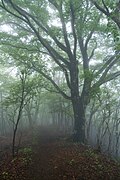 |
Fagus japonica Maxim. | Englerianae | Widespread species; insular sister species of F. engleriana[4][5][8] | Japan; Kyushu, Shikoku and Honshu from sea-level up to c. 1500 m a.s.l. | Yes |
| Fagus longipetiolata Seemen | Fagus | Sym- to parapatric with F. lucida and F. pashanica, and sharing alleles with both species in addition to alleles indicating a sister relationship with the Japanese F. crenata.[4][8] | China, south of the Yellow River, into N. Vietnam; in montane areas up to 2400 m a.s.l.[20] | Replaced by F. sinensis | |
 |
Fagus lucida Rehder & E.H.Wilson | Fagus | Rare species; closest relatives are F. crenata[4][5][6] and F. longipetiolata[4][8] | China; south of the Yellow River in montane areas between 800–2000 m a.s.l.[21] | Yes |
| Fagus mexicana Martínez | Fagus | Narrow endemic sister species of F. grandifolia. F. mexicana differs from F. grandifolia by its slender leaves and less-evolved but more polymorphic set of alleles (higher level of heterozygosity)[4][8] | Hidalgo, Mexico; at 1400–2000 m a.s.l. as an element of the subtropical montane mesophilic forest"(bosque mesófilo de montaña) superimposing the tropical lowland rainforests. | No, populations included in F. grandifolia | |
| Fagus multinervis Nakai | Englerianae | Narrow endemic species, first diverging lineage within subgenus Englerianae[4][8] | South Korea (Ulleungdo) | Yes | |
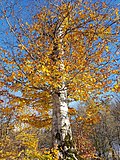 |
Fagus orientalis Lipsky – Oriental beech (in a narrow sense) | Fagus | Sister species of F. sylvatica[17][18] | Southeastern Europe (SE Bulgaria, NE Greece, European Turkey) and adjacent northwestern Asia (NW and N Anatolia) | No, treated as subspecies of F. sylvatica |
| Fagus pashanica C.C.Yang | Fagus | Continental sister species of F. hayatae, with a set of alleles that puts it closer to F. longipetiolata and F. crenata than its insular sister. | China (Hubei, Hunan, Shaanxi, Sichuan, Zhejiang), at 1300–2300 m a.s.l.(eFlora of China, as F. hayatae[22]) | Yes | |
| Fagus sinensis Oliv. | Fagus | Invalid; the original material included material from two much different species: F. engleriana and F. longipetiolata[1][6] | China (Hubei), Vietnam | Yes, erroneously used as older synonym of F. longipetiolata | |
 |
Fagus sylvatica L. – European beech | Fagus | Sister species of and closely related to F. orientalis[17][18] | Europe | Yes |
Natural and potential hybrids
[edit]| Image | Name | Parentage | Status | Distribution |
|---|---|---|---|---|
| Fagus (×) moesiaca (K. Malý) Czeczott | F. sylvatica × F. orientalis | No evidence so far for hybrid origin. All individuals addressed as F. moesiaca included in genetic studies fell within the variation of F. sylvatica.[5][23] They may represent a lowland ecotype of F. sylvatica.[1][24]
Erroneously synonymized by some authors (e.g. POWO) with the Crimean F. × taurica, from which it differs morphologically and genetically. |
Southeastern Balkans | |
| Fagus okamotoi Shen | F. crenata × F. japonica ? | Unique phenotype, described from an area in which F. crenata and F. japonica are sympatric. So far, there is no genetic evidence for ongoing gene flow between the two Japanese species, which belong to different subgeneric lineages. | Kanto, eastern Honshu | |
 |
Fagus × taurica Popl. – Crimean beech | F. sylvatica × F. orientalis s.l. | Hybrid status not yet tested by genetic data; according to isoenzyme profiles a less-evolved, relict population of F. sylvatica or intermediate between F. sylvatica and the species complex historically addressed as Oriental beech (F. orientalis in a broad sense)[16] | Crimean peninsula |
Fossil species
[edit]Numerous species have been named globally from the fossil record spanning from the Cretaceous to the Pleistocene[25].
- †Fagus aburatoensis Tanai, 1951[26]
- †Fagus alnitifolia Hollick[27]
- †Fagus altaensis Kornilova & Rajushkina, 1979
- †Fagus ambigua (Massalongo) Massalongo, 1853
- †Fagus angusta Andreánszky, 1959
- †Fagus antipofii Heer, 1858
- †Fagus aperta Andreánszky, 1959
- †Fagus arduinorum Massalongo, 1858
- †Fagus aspera (Berry) Brown, 1944
- †Fagus aspera Chelebaeva, 2005 (jr homonym)
- †Fagus atlantica Unger, 1847
- †Fagus attenuata Göppert, 1855
- †Fagus aurelianii Marion & Laurent, 1895
- †Fagus australis Oliver, 1936
- †Fagus betulifolia Massalongo, 1858
- †Fagus bonnevillensis Chaney, 1920
- †Fagus castaneifolia Unger, 1847
- †Fagus celastrifolia Ettingshausen, 1887
- †Fagus ceretana (Rérolle) Saporta, 1892
- †Fagus chamaephegos Unger, 1861
- †Fagus chankaica Alexeenko, 1977
- †Fagus chiericii Massalongo, 1858
- †Fagus chinensis Li, 1978
- †Fagus coalita Rylova, 1996
- †Fagus cordifolia Heer, 1883
- †Fagus cretacea Newberry, 1868
- †Fagus decurrens Reid & Reid, 1915
- †Fagus dentata Göppert, 1855
- †Fagus deucalionis Unger, 1847
- †Fagus dubia Mirb, 1822
- †Fagus dubia Watelet, 1866 (jr homonym)
- †Fagus echinata Chelebaeva, 2005
- †Fagus eocenica Watelet, 1866
- †Fagus etheridgei Ettingshausen, 1891
- †Fagus ettingshausenii Velenovský, 1881
- †Fagus europaea Schwarewa, 1960
- †Fagus evenensis Chelebaeva, 1980
- †Fagus faujasii Unger, 1850
- †Fagus feroniae Unger, 1845
- †Fagus florinii Huzioka & Takahashi, 1973
- †Fagus forumlivii Massalongo, 1853
- †Fagus friedrichii Grímsson & Denk, 2005
- †Fagus gortanii Fiori, 1940
- †Fagus grandifoliiformis Panova, 1966
- †Fagus gussonii Massalongo, 1858
- †Fagus haidingeri Kováts, 1856
- †Fagus herthae (Unger) Iljinskaja, 1964
- †Fagus hitchcockii Lesquereux, 1861
- †Fagus hondoensis (Watari) Watari, 1952
- †Fagus hookeri Ettingshausen, 1887
- †Fagus horrida Ludwig, 1858
- †Fagus humata Menge & Göppert, 1886
- †Fagus idahoensis Chaney & Axelrod, 1959
- †Fagus inaequalis Göppert, 1855
- †Fagus incerta (Massalongo) Massalongo, 1858
- †Fagus integrifolia Dusén, 1899
- †Fagus intermedia Nathorst, 1888
- †Fagus irvajamensis Chelebaeva, 1980
- †Fagus japoniciformis Ananova, 1974
- †Fagus japonicoides Miki, 1963
- †Fagus jobanensis Suzuki, 1961
- †Fagus jonesii Johnston, 1892
- †Fagus juliae Jakubovskaya, 1975
- †Fagus kitamiensis Tanai, 1995
- †Fagus koraica Huzioka, 1951
- †Fagus kraeuselii Kvaček & Walther, 1991
- †Fagus kuprianoviae Rylova, 1996
- †Fagus lancifolia Heer, 1868 (nomen nudum)
- †Fagus langevinii Manchester & Dillhoff, 2004[28]
- †Fagus laptoneura Ettingshausen, 1895
- †Fagus latissima Andreánszky, 1959
- †Fagus leptoneuron Ettingshausen, 1893
- †Fagus macrophylla Unger, 1854
- †Fagus maorica Oliver, 1936
- †Fagus marsillii Massalongo, 1858
- †Fagus menzelii Kvaček & Walther, 1991
- †Fagus microcarpa Miki, 1933
- †Fagus miocenica Ananova, 1974
- †Fagus napanensis Iljinskaja, 1982
- †Fagus nelsonica Ettingshausen, 1887
- †Fagus oblonga Suzuki, 1959
- †Fagus oblonga Andreánszky, 1959
- †Fagus obscura Dusén, 1908
- †Fagus olejnikovii Pavlyutkin, 2015
- †Fagus orbiculatum Lesquereux, 1892
- †Fagus orientaliformis Kul'kova
- †Fagus orientalis var fossilis Kryshtofovich & Baikovskaja, 1951
- †Fagus orientalis var palibinii Iljinskaja, 1982
- †Fagus pacifica Chaney, 1927
- †Fagus palaeococcus Unger, 1847
- †Fagus palaeocrenata Okutsu, 1955
- †Fagus palaeograndifolia Pavlyutkin, 2002
- †Fagus palaeojaponica Tanai & Onoe, 1961
- †Fagus pittmanii Deane, 1902
- †Fagus pliocaenica Geyler & Kinkelin, 1887 (jr homonym)
- †Fagus pliocenica Saporta, 1882
- †Fagus polycladus Lesquereux, 1868
- †Fagus praelucida Li, 1982
- †Fagus praeninnisiana Ettingshausen, 1893
- †Fagus praeulmifolia Ettingshausen, 1893
- †Fagus prisca Ettingshausen, 1867
- †Fagus pristina Saporta, 1867
- †Fagus producta Ettingshausen, 1887
- †Fagus protojaponica Suzuki, 1959
- †Fagus protolongipetiolata Huzioka, 1951
- †Fagus protonucifera Dawson, 1884
- †Fagus pseudoferruginea Lesquereux, 1878
- †Fagus pygmaea Unger, 1861
- †Fagus pyrrhae Unger, 1854
- †Fagus salnikovii Fotjanova, 1988
- †Fagus sanctieugeniensis Hollick, 1927
- †Fagus saxonica Kvaček & Walther, 1991
- †Fagus schofieldii Mindell, Stockey, & Beard, 2009
- †Fagus septembris Chelebaeva, 1991
- †Fagus shagiana Ettingshausen, 1891
- †Fagus stuxbergii Tanai, 1976
- †Fagus subferruginea Wilf et al., 2005[29]
- †Fagus succinea Göppert & Menge, 1853
- †Fagus sylvatica var diluviana Saporta, 1892
- †Fagus sylvatica var pliocenica Saporta, 1873
- †Fagus tenella Panova, 1966
- †Fagus uemurae Tanai, 1995
- †Fagus uotanii Huzioka, 1951
- †Fagus vivianii Unger, 1850
- †Fagus washoensis LaMotte, 1936
Fossil species formerly placed in Fagus include:[25]
- †Alnus paucinervis (Borsuk) Iljinskaja
- †Castanea abnormalis (Fotjanova) Iljinskaja
- †Fagopsis longifolia (Lesquereux) Hollick
- †Fagopsis undulata (Knowlton) Wolfe & Wehr
- †Fagoxylon grandiporosum (Beyer) Süss
- †Fagus-pollenites parvifossilis (Traverse) Potonié
- †Juglans ginannii Massalongo (new name for F. ginannii)
- †Nothofagaphyllites novae-zealandiae (Oliver) Campbell
- †Nothofagus benthamii (Ettingshausen) Paterson
- †Nothofagus dicksonii (Dusén) Tanai
- †Nothofagus lendenfeldii (Ettingshausen) Oliver
- †Nothofagus luehmannii (Deane) Paterson
- †Nothofagus magelhaenica (Ettingshausen) Dusén
- †Nothofagus maidenii (Deane) Chapman
- †Nothofagus muelleri (Ettingshausen) Paterson
- †Nothofagus ninnisiana (Unger) Oliver
- †Nothofagus risdoniana (Ettingshausen) Paterson
- †Nothofagus ulmifolia (Ettingshausen) Oliver
- †Nothofagus wilkinsonii (Ettingshausen) Paterson
- †Trigonobalanus minima (M. Chandler) Mai
Etymology
[edit]The name of the tree in Latin, fagus (from whence the generic epithet), is cognate with English "beech" and of Indo-European origin, and played an important role in early debates on the geographical origins of the Indo-European people, the beech argument. Greek φηγός (figós) is from the same root, but the word was transferred to the oak tree (e.g. Iliad 16.767) as a result of the absence of beech trees in southern Greece.[30]
Distribution and habitat
[edit]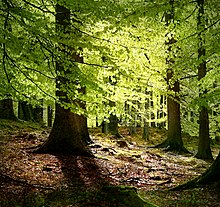


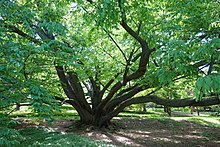
Britain and Ireland
[edit]Fagus sylvatica was a late entrant to Great Britain after the last glaciation, and may have been restricted to basic soils in the south of England. Some suggest that it was introduced by Neolithic tribes who planted the trees for their edible nuts.[31] The beech is classified as a native in the south of England and as a non-native in the north where it is often removed from 'native' woods.[32] Large areas of the Chilterns are covered with beech woods, which are habitat to the common bluebell and other flora. The Cwm Clydach National Nature Reserve in southeast Wales was designated for its beech woodlands, which are believed to be on the western edge of their natural range in this steep limestone gorge.[33]
Beech is not native to Ireland; however, it was widely planted in the 18th century and can become a problem shading out the native woodland understory.
Beech is widely planted for hedging and in deciduous woodlands, and mature, regenerating stands occur throughout mainland Britain at elevations below about 650 m (2,100 ft).[34] The tallest and longest hedge in the world (according to Guinness World Records) is the Meikleour Beech Hedge in Meikleour, Perth and Kinross, Scotland.
Continental Europe
[edit]Fagus sylvatica is one of the most common hardwood trees in north-central Europe, in France constituting alone about 15% of all nonconifers. The Balkans are also home to the lesser-known oriental beech (F. orientalis) and Crimean beech (F. taurica).
As a naturally growing forest tree, beech marks the important border between the European deciduous forest zone and the northern pine forest zone. This border is important for wildlife and fauna.
In Denmark and Scania at the southernmost peak of the Scandinavian peninsula, southwest of the natural spruce boundary, it is the most common forest tree. It grows naturally in Denmark and southern Norway and Sweden up to about 57–59°N. The most northern known naturally growing (not planted) beech trees are found in a small grove north of Bergen on the west coast of Norway. Near the city of Larvik is the largest naturally occurring beech forest in Norway, Bøkeskogen.
Some research suggests that early agriculture patterns supported the spread of beech in continental Europe. Research has linked the establishment of beech stands in Scandinavia and Germany with cultivation and fire disturbance, i.e. early agricultural practices. Other areas which have a long history of cultivation, Bulgaria for example, do not exhibit this pattern, so how much human activity has influenced the spread of beech trees is as yet unclear.[35]
The primeval beech forests of the Carpathians are also an example of a singular, complete, and comprehensive forest dominated by a single tree species - the beech tree. Forest dynamics here were allowed to proceed without interruption or interference since the last ice age. Nowadays, they are amongst the last pure beech forests in Europe to document the undisturbed postglacial repopulation of the species, which also includes the unbroken existence of typical animals and plants. These virgin beech forests and similar forests across 12 countries in continental Europe were inscribed on the UNESCO World Heritage List in 2007.[36]
North America
[edit]The American beech (Fagus grandifolia) occurs across much of the eastern United States and southeastern Canada, with a disjunct sister species in Mexico (F. mexicana). Their are the only extant (surviving) Fagus species in the Western Hemisphere. Before the Pleistocene Ice Age, it is believed to have spanned the entire width of the continent from the Atlantic Ocean to the Pacific but now is confined to the east of the Great Plains. F. grandifolia tolerates hotter climates than European species but is not planted much as an ornamental due to slower growth and less resistance to urban pollution. It most commonly occurs as an overstory component in the northern part of its range with sugar maple, transitioning to other forest types further south such as beech-magnolia. American beech is rarely encountered in developed areas except as a remnant of a forest that was cut down for land development.
The dead brown leaves of the American beech remain on the branches until well into the following spring, when the new buds finally push them off.
Asia
[edit]East Asia is home to eight species of Fagus, only one of which (F. crenata) is occasionally planted in Western countries. Smaller than F. sylvatica and F. grandifolia, this beech is one of the most common hardwoods in its native range.
Ecology
[edit]Beech grows on a wide range of soil types, acidic or basic, provided they are not waterlogged. The tree canopy casts dense shade and thickens the ground with leaf litter.
In North America, they can form beech-maple climax forests by partnering with the sugar maple.
The beech blight aphid (Grylloprociphilus imbricator) is a common pest of American beech trees. Beeches are also used as food plants by some species of Lepidoptera.
Beech bark is extremely thin and scars easily. Since the beech tree has such delicate bark, carvings, such as lovers' initials and other forms of graffiti, remain because the tree is unable to heal itself.[37]
Diseases
[edit]Beech bark disease is a fungal infection that attacks the American beech through damage caused by scale insects.[38] Infection can lead to the death of the tree.[39]
Beech leaf disease is a disease that affects American beeches spread by the newly discovered nematode, Litylenchus crenatae mccannii. This disease was first discovered in Lake County, Ohio, in 2012 and has now spread to over 41 counties in Ohio, Pennsylvania, New York, and Ontario, Canada.[40] As of 2024, the disease has become widespread in Connecticut, Massachusetts and Rhode Island, and in portions of coastal New Hampshire and coastal and central Maine.[41]
Cultivation
[edit]The beech most commonly grown as an ornamental tree is the European beech (Fagus sylvatica), widely cultivated in North America as well as its native Europe. Many varieties are in cultivation, notably the weeping beech F. sylvatica 'Pendula', several varieties of copper or purple beech, the fern-leaved beech F. sylvatica 'Asplenifolia', and the tricolour beech F. sylvatica 'Roseomarginata'. The columnar Dawyck beech (F. sylvatica 'Dawyck') occurs in green, gold, and purple forms, named after Dawyck Botanic Garden in the Scottish Borders, one of the four garden sites of the Royal Botanic Garden Edinburgh.
Uses
[edit]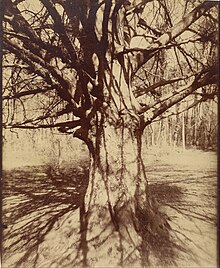
Wood
[edit]Beech wood is an excellent firewood, easily split and burning for many hours with bright but calm flames. Slats of beech wood are washed in caustic soda to leach out any flavour or aroma characteristics and are spread around the bottom of fermentation tanks for Budweiser beer. This provides a complex surface on which the yeast can settle, so that it does not pile up, preventing yeast autolysis which would contribute off-flavours to the beer.[citation needed] Beech logs are burned to dry the malt used in German smoked beers.[42] Beech is also used to smoke Westphalian ham,[43] traditional andouille (an offal sausage) from Normandy,[44] and some cheeses.
Some drums are made from beech, which has a tone between those of maple and birch, the two most popular drum woods.
The textile modal is a kind of rayon often made wholly from reconstituted cellulose of pulped beech wood.[45][46][47]
The European species Fagus sylvatica yields a tough, utility timber. It weighs about 720 kg per cubic metre and is widely used for furniture construction, flooring, and engineering purposes, in plywood and household items, but rarely as a decorative wood. The timber can be used to build chalets, houses, and log cabins.[citation needed]
Beech wood is used for the stocks of military rifles when traditionally preferred woods such as walnut are scarce or unavailable or as a lower-cost alternative.[48]
Food
[edit]The edible fruit of the beech tree,[3] known as beechnuts or mast, is found in small burrs that drop from the tree in autumn. They are small, roughly triangular, and edible, with a bitter, astringent, or in some cases, mild and nut-like taste. According to the Roman statesman Pliny the Elder in his work Natural History, beechnut was eaten by the people of Chios when the town was besieged, writing of the fruit: "that of the beech is the sweetest of all; so much so, that, according to Cornelius Alexander, the people of the city of Chios, when besieged, supported themselves wholly on mast".[49] They can also be roasted and pulverized into an adequate coffee substitute.[50] The leaves can be steeped in liquor to give a light green/yellow liqueur.
Books
[edit]
In antiquity, the bark of the beech tree was used by Indo-European people for writing-related purposes, especially in a religious context.[51] Beech wood tablets were a common writing material in Germanic societies before the development of paper. The Old English bōc[52] has the primary sense of "beech" but also a secondary sense of "book", and it is from bōc that the modern word derives.[53] In modern German, the word for "book" is Buch, with Buche meaning "beech tree". In modern Dutch, the word for "book" is boek, with beuk meaning "beech tree". In Swedish, these words are the same, bok meaning both "beech tree" and "book". There is a similar relationship in some Slavic languages. In Russian and Bulgarian, the word for beech is бук (buk), while that for "letter" (as in a letter of the alphabet) is буква (bukva), while Serbo-Croatian and Slovene use "bukva" to refer to the tree.
Other
[edit]The pigment bistre was made from beech wood soot. Beech litter raking as a replacement for straw in animal husbandry was an old non-timber practice in forest management that once occurred in parts of Switzerland in the 17th century.[54][55][56][57] Beech has been listed as one of the 38 plants whose flowers are used to prepare Bach flower remedies.[58]
See also
[edit]- Ancient and Primeval Beech Forests of the Carpathians and Other Regions of Europe
- English Lowlands beech forests
- Weeping Beech (Queens)
References
[edit]- ^ a b c d e f g h i j k l Denk, Thomas; Grimm, Guido W.; Cardoni, Simone; Csilléry, Katalin; Kurz, Mirjam; Schulze, Ernst-Detlef; Simeone, Marco Cosimo; Worth, James R. P. (2024). "A subgeneric classification of Fagus (Fagaceae) and revised taxonomy of western Eurasian beeches". Willdenowia. 54 (2–3). doi:10.3372/wi.54.54301. ISSN 0511-9618.
- ^ a b c Shen, Chung-Fu (1992). A Monograph of the Genus Fagus Tourn. Ex L. (Fagaceae) (PhD). City University of New York. OCLC 28329966.
- ^ a b Lyle, Katie Letcher (2010) [2004]. The Complete Guide to Edible Wild Plants, Mushrooms, Fruits, and Nuts: How to Find, Identify, and Cook Them (2nd ed.). Guilford, CN: FalconGuides. p. 138. ISBN 978-1-59921-887-8. OCLC 560560606.
- ^ a b c d e f g h i j k l m n Cardoni, Simone; Piredda, Roberta; Denk, Thomas; Grimm, Guido W.; Papageorgiou, Aristotelis C.; Schulze, Ernst-Detlef; Scoppola, Anna; Shanjani, Parvin Salehi; Suyama, Yoshihisa (2021-10-19), 5S-IGS rDNA in wind-pollinated trees (Fagus L.) encapsulates 55 million years of reticulate evolution and hybrid origins of modern species, doi:10.1101/2021.02.26.433057, retrieved 2024-10-24
- ^ a b c d e f Denk, Thomas; Grimm, Guido W.; Hemleben, Vera (June 2005). "Patterns of molecular and morphological differentiation in Fagus (Fagaceae): phylogenetic implications". American Journal of Botany. 92 (6): 1006–1016. doi:10.3732/ajb.92.6.1006. ISSN 0002-9122.
- ^ a b c d Denk, T. (2003-09-01). "Phylogeny of Fagus L. (Fagaceae) based on morphological data". Plant Systematics and Evolution. 240 (1): 55–81. doi:10.1007/s00606-003-0018-x. ISSN 1615-6110.
- ^ Oh, Sang-Hun; Youm, Jung-Won; Kim, Yong-In; Kim, Young-Dong (2016-09-01). "Phylogeny and Evolution of Endemic Species on Ulleungdo Island, Korea: The Case of Fagus multinervis (Fagaceae)". Systematic Botany. 41 (3): 617–625. doi:10.1600/036364416X692271.
- ^ a b c d e f g h i Jiang, Lu; Bao, Qin; He, Wei; Fan, Deng‐Mei; Cheng, Shan‐Mei; López‐Pujol, Jordi; Chung, Myong Gi; Sakaguchi, Shota; Sánchez‐González, Arturo; Gedik, Aysun; Li, De‐Zhu; Kou, Yi‐Xuan; Zhang, Zhi‐Yong (2022-07). "Phylogeny and biogeography of Fagus (Fagaceae) based on 28 nuclear single/low‐copy loci". Journal of Systematics and Evolution. 60 (4): 759–772. doi:10.1111/jse.12695. ISSN 1674-4918.
{{cite journal}}: Check date values in:|date=(help) - ^ a b c Grímsson, Friðgeir; Grimm, Guido W.; Zetter, Reinhard; Denk, Thomas (2016-12-01). "Cretaceous and Paleogene Fagaceae from North America and Greenland: evidence for a Late Cretaceous split between Fagus and the remaining Fagaceae". Acta Palaeobotanica. 56 (2): 247–305. doi:10.1515/acpa-2016-0016. ISSN 2082-0259.
- ^ Denk, Thomas; Grimm, Guido W. (2009). "The biogeographic history of beech trees". Review of Palaeobotany and Palynology. 158 (1–2): 83–100. doi:10.1016/j.revpalbo.2009.08.007.
- ^ Renner, S. S.; Grimm, Guido W.; Kapli, Paschalia; Denk, Thomas (2016-07-19). "Species relationships and divergence times in beeches: new insights from the inclusion of 53 young and old fossils in a birth–death clock model". Philosophical Transactions of the Royal Society B: Biological Sciences. 371 (1699): 20150135. doi:10.1098/rstb.2015.0135. ISSN 0962-8436. PMC 4920336. PMID 27325832.
- ^ Zhou, Biao-Feng; Yuan, Shuai; Crowl, Andrew A.; Liang, Yi-Ye; Shi, Yong; Chen, Xue-Yan; An, Qing-Qing; Kang, Ming; Manos, Paul S.; Wang, Baosheng (2022-03-14). "Phylogenomic analyses highlight innovation and introgression in the continental radiations of Fagaceae across the Northern Hemisphere". Nature Communications. 13 (1): 1320. doi:10.1038/s41467-022-28917-1. ISSN 2041-1723. PMC 8921187. PMID 35288565.
- ^ Manos, Paul S.; Steele, Kelly P. (1997). "Phylogenetic analysis of "Higher" Hamamelididae based on Plasid Sequence Data". American Journal of Botany. 84 (10): 1407–19. doi:10.2307/2446139. JSTOR 2446139. PMID 21708548.
- ^ "Fagus L. - Plants of the World Online". Plants of the World Online. 2022-05-07. Retrieved 2023-04-24.
- ^ Li, Dan-Qi; Jiang, Lu; Liang, Hua; Zhu, Da-Hai; Fan, Deng-Mei; Kou, Yi-Xuan; Yang, Yi; Zhang, Zhi-Yong (2023-09-01). "Resolving a nearly 90-year-old enigma: The rare Fagus chienii is conspecific with F. hayatae based on molecular and morphological evidence". Plant Diversity. 45 (5): 544–551. doi:10.1016/j.pld.2023.01.003. ISSN 2468-2659. PMC 10625896. PMID 37936819.
- ^ a b Gömöry, Dušan; Paule, Ladislav (2010-07-01). "Reticulate evolution patterns in western-Eurasian beeches". Botanica Helvetica. 120 (1): 63–74. doi:10.1007/s00035-010-0068-y. ISSN 1420-9063.
- ^ a b c Gömöry, Dušan; Paule, Ladislav; Mačejovský, Vladimír (2018-06-29). "Phylogeny of beech in western Eurasia as inferred by approximate Bayesian computation". Acta Societatis Botanicorum Poloniae. 87 (2). doi:10.5586/asbp.3582. ISSN 2083-9480.
- ^ a b c Kurz, Mirjam; Kölz, Adrian; Gorges, Jonas; Pablo Carmona, Beatriz; Brang, Peter; Vitasse, Yann; Kohler, Martin; Rezzonico, Fabio; Smits, Theo H. M.; Bauhus, Jürgen; Rudow, Andreas; Kim Hansen, Ole; Vatanparast, Mohammad; Sevik, Hakan; Zhelev, Petar (2023-03-01). "Tracing the origin of Oriental beech stands across Western Europe and reporting hybridization with European beech – Implications for assisted gene flow". Forest Ecology and Management. 531: 120801. doi:10.1016/j.foreco.2023.120801. ISSN 0378-1127.
- ^ Sękiewicz, Katarzyna; Danelia, Irina; Farzaliyev, Vahid; Gholizadeh, Hamid; Iszkuło, Grzegorz; Naqinezhad, Alireza; Ramezani, Elias; Thomas, Peter A.; Tomaszewski, Dominik; Walas, Łukasz; Dering, Monika (2022). "Past climatic refugia and landscape resistance explain spatial genetic structure in Oriental beech in the South Caucasus". Ecology and Evolution. 12 (9). doi:10.1002/ece3.9320. ISSN 2045-7758. PMC 9490144. PMID 36188519.
- ^ "Fagus longipetiolata in Flora of China @ efloras.org". www.efloras.org. Retrieved 2024-10-24.
- ^ "Fagus lucida in Flora of China @ efloras.org". www.efloras.org. Retrieved 2024-10-24.
- ^ "Fagus hayatae in Flora of China @ efloras.org". www.efloras.org. Retrieved 2024-10-24.
- ^ Ulaszewski, Bartosz; Meger, Joanna; Mishra, Bagdevi; Thines, Marco; Burczyk, Jarosław (2021). "Complete Chloroplast Genomes of Fagus sylvatica L. Reveal Sequence Conservation in the Inverted Repeat and the Presence of Allelic Variation in NUPTs". Genes. 12 (9): 1357. doi:10.3390/genes12091357. ISSN 2073-4425. PMC 8468245. PMID 34573338.
{{cite journal}}: CS1 maint: unflagged free DOI (link) - ^ Denk, Th. (January 1999). "The taxonomy of Fagus in western Eurasia. 2: Fagus sylvatica subsp. sylvatica". Feddes Repertorium. 110 (5–6): 381–412. doi:10.1002/fedr.19991100510. ISSN 0014-8962.
- ^ a b "Fagus". The International Fossil Plant Names Index. Retrieved 6 Feb 2023.
- ^ Tanai, T. "Des fossiles végétaux dans le bassin houiller de Nishitagawa, Préfecture de Yamagata, Japon". Japanese Journal of Geology and Geography. 22: 119–135.
- ^ Brown, R. W. (1937). Additions to some fossil floras of the Western United States (PDF) (Report). Professional Paper. Vol. 186. United States Geological Survey. pp. 163–206. doi:10.3133/pp186J.
- ^ Manchester, S. R.; Dillhoff, R. M. (2004). "Fagus (Fagaceae) fruits, foliage, and pollen from the Middle Eocene of Pacific Northwestern North America". Canadian Journal of Botany. 82 (10): 1509–1517. doi:10.1139/b04-112.
- ^ Wilf, P.; Johnson, K.R.; Cúneo, N.R.; Smith, M.E.; Singer, B.S.; Gandolfo, M.A. (2005). "Eocene Plant Diversity at Laguna del Hunco and Río Pichileufú, Patagonia, Argentina". The American Naturalist. 165 (6): 634–650. doi:10.1086/430055. PMID 15937744. S2CID 3209281. Retrieved 2019-02-22.
- ^ Robert Beekes, Etymological Dictionary of Greek, Leiden and Boston 2010, pp. 1565–6
- ^ "Map" (JPG). linnaeus.nrm.se. Retrieved 2019-08-07.
- ^ "International Foresters Study Lake District's greener, friendlier forests". Forestry Commission. Archived from the original on 28 January 2010. Retrieved 4 August 2010.
- ^ "Cwm Clydach". Countryside Council for Wales Landscape & wildlife. Archived from the original on 25 September 2010. Retrieved 4 August 2010.
- ^ Preston, C.D.; Pearman, D.; Dines, T.D. (2002). New Atlas of the British Flora. Oxford University Press. ISBN 978-0-19-851067-3.
- ^ Bradshaw, R.H.W.; Kito and, N.; Giesecke, T. (2010). "Factors influencing the Holocene history of Fagus". Forest Ecology and Management. 259 (11): 2204–12. doi:10.1016/j.foreco.2009.11.035.
- ^ "Ancient and Primeval Beech Forests of the Carpathians and Other Regions of Europe". UNESCO World Heritage Centre. United Nations Educational, Scientific, and Cultural Organization. Retrieved 13 November 2021.
- ^ Lawrence, Gale; Tyrol, Adelaide (1984). A Field Guide to the Familiar: Learning to Observe the Natural World. Prentice-Hall. pp. 75–76. ISBN 978-0-13-314071-2.
- ^ "beech." The Columbia Encyclopedia. New York: Columbia University Press, 2008. Credo Reference. Web. 17 September 2012.
- ^ "beech bark disease". Dictionary of Microbiology & Molecular Biology. Wiley. 2006. ISBN 978-0-470-03545-0. Credo Reference. Web. 27 September 2012.
- ^ Crowley, Brendan (2020-09-28). "Deadly 'Beech Leaf Disease' Identified Across Connecticut and Rhode Island". The Connecticut Examiner. Retrieved 2020-11-15.
- ^ University of New Hampshire
- ^ "Der Brauprozeß von Schlenkerla Rauchbier". Schlenkerla - die historische Rauchbierbrauerei (in German). Schlenkerla. 2011. Retrieved 11 December 2020.
- ^ "GermanFoods.org - Guide to German Sausages and German Hams". Archived from the original on 2012-11-23. Retrieved 2012-05-17.
- ^ "What is andouille? | Cookthink". Archived from the original on 2012-05-12. Retrieved 2012-11-22.
- ^ holistic-interior-designs.com, Modal Fabric Archived 2011-10-09 at the Wayback Machine, retrieved 9 October 2011
- ^ uniformreuse.co.uk, Modal data sheet Archived 2011-10-24 at the Wayback Machine, retrieved 9 October 2011
- ^ fabricstockexchange.com, Modal Archived 2011-09-25 at the Wayback Machine (dictionary entry), retrieved 9 October 2011
- ^ Walter, J. (2006). Rifles of the World (3rd ed.). Krause Publications. ISBN 978-0-89689-241-5.
- ^ "How did beech mast save the people of Chios? - Interesting Earth". interestingearth.com. Retrieved 2019-10-07.
- ^ United States Department of the Army (2009). The Complete Guide to Edible Wild Plants. New York: Skyhorse Publishing. p. 29. ISBN 978-1-60239-692-0. OCLC 277203364.
- ^ Pronk-Tiethoff, Saskia (25 October 2013). The Germanic loanwords in Proto-Slavic. Rodopi. p. 81. ISBN 978-94-012-0984-7.
- ^ A Concise Anglo-Saxon Dictionary, Second Edition (1916), Blōtan-Boldwela, John Richard Clark Hall
- ^ Douglas Harper. "Book". Online Etymological Dictionary. Retrieved 2011-11-18.
- ^ Bürgi, M.; Gimmi, U. (2007). "Three objectives of historical ecology: the case of litter collecting in Central European forests" (PDF). Landscape Ecology. 22 (S1): 77–87. Bibcode:2007LaEco..22S..77B. doi:10.1007/s10980-007-9128-0. hdl:20.500.11850/58945. S2CID 21130814.
- ^ Gimmi, U.; Poulter, B.; Wolf, A.; Portner, H.; Weber, P.; Bürgi, M. (2013). "Soil carbon pools in Swiss forests show legacy effects from historic forest litter raking" (PDF). Landscape Ecology. 28 (5): 385–846. Bibcode:2013LaEco..28..835G. doi:10.1007/s10980-012-9778-4. hdl:20.500.11850/66782. S2CID 16930894.
- ^ McGrath, M.J.; et al. (2015). "Reconstructing European forest management from 1600 to 2010". Biogeosciences. 12 (14): 4291–4316. Bibcode:2015BGeo...12.4291M. doi:10.5194/bg-12-4291-2015.
- ^ Scalenghe, R.; Minoja, A.P.; Zimmermann, S.; Bertini, S. (2016). "Consequence of litter removal on pedogenesis: A case study in Bachs and Irchel (Switzerland)". Geoderma. 271: 191–201. Bibcode:2016Geode.271..191S. doi:10.1016/j.geoderma.2016.02.024.
- ^ D. S. Vohra (1 June 2004). Bach Flower Remedies: A Comprehensive Study. B. Jain Publishers. p. 3. ISBN 978-81-7021-271-3. Retrieved 2 September 2013.
External links
[edit]- "WCSP". World Checklist of Selected Plant Families – Fagus.
- Eichhorn, Markus (October 2010). "The Beech Tree". Test Tube. Brady Haran for the University of Nottingham.
- Traditional and Modern Use of Beech
